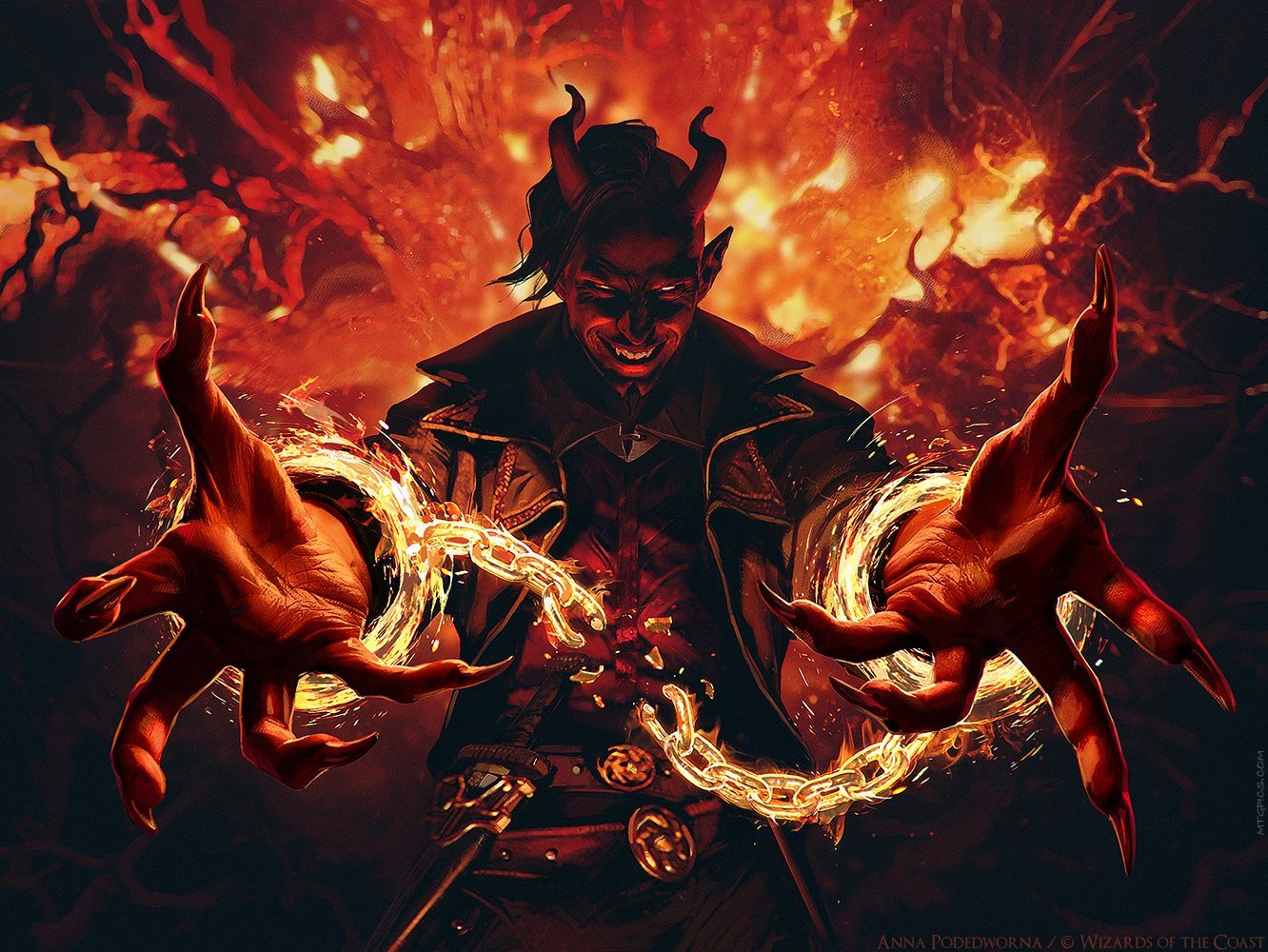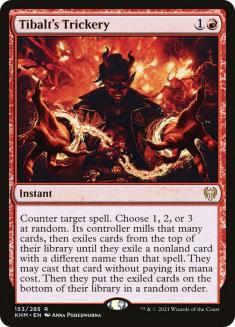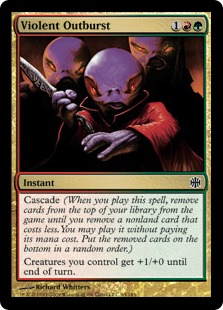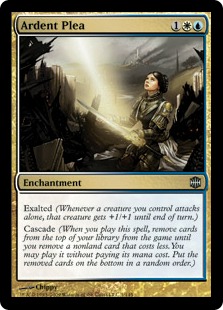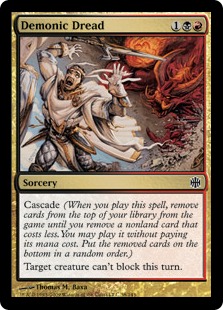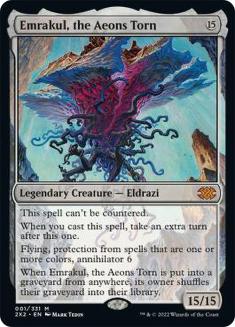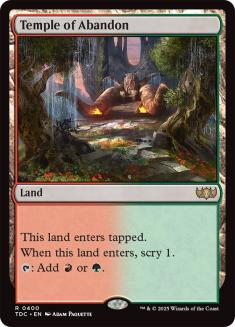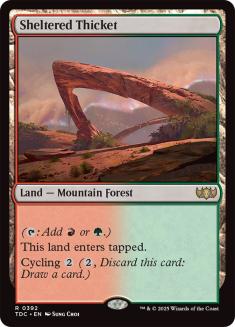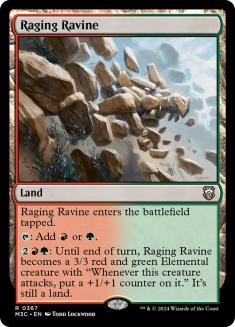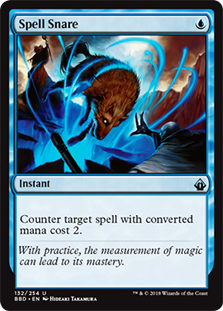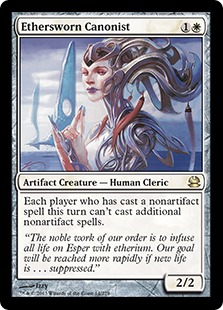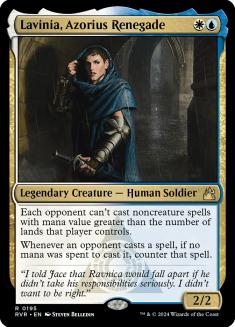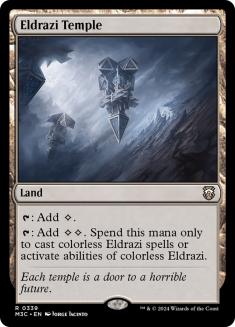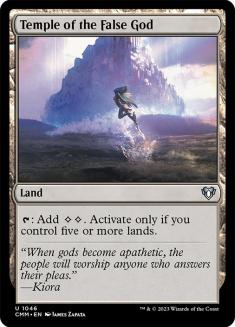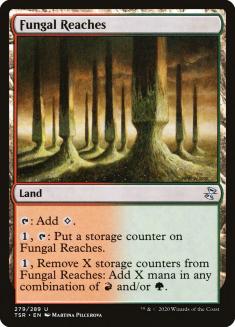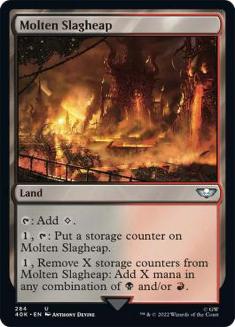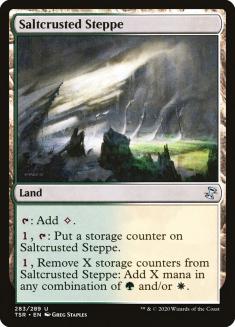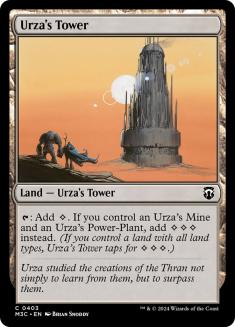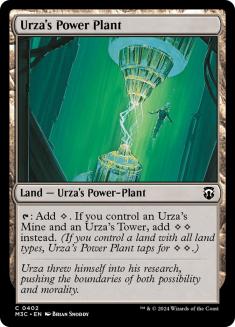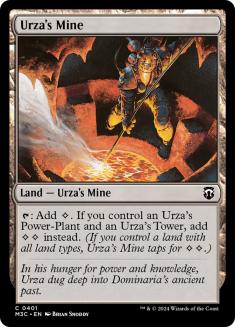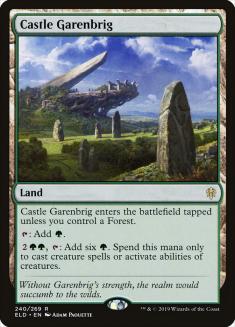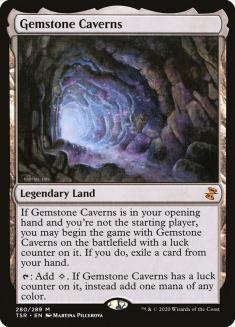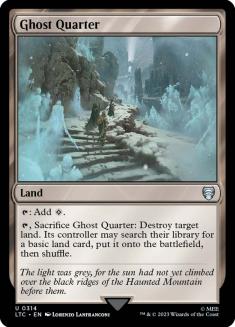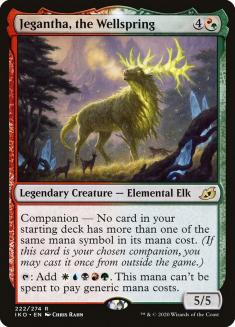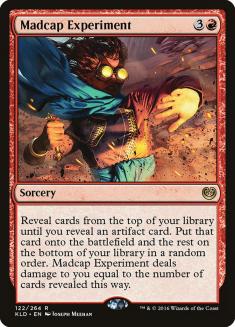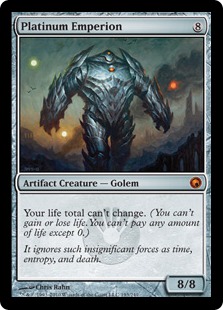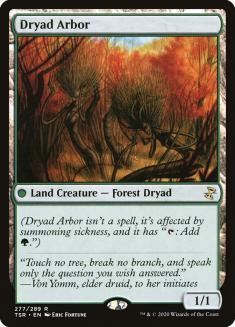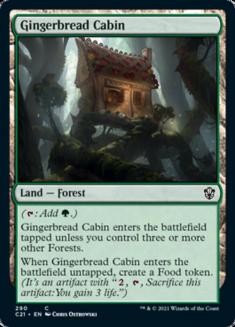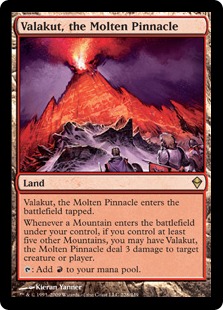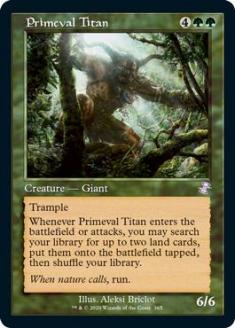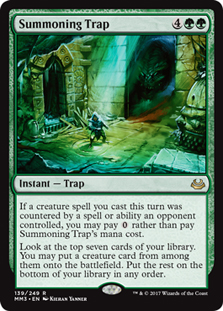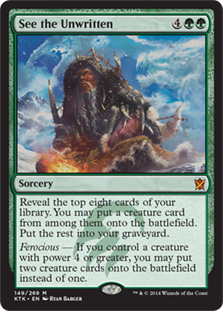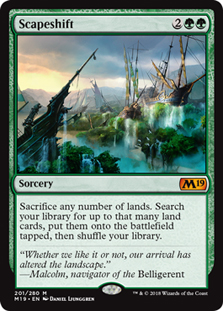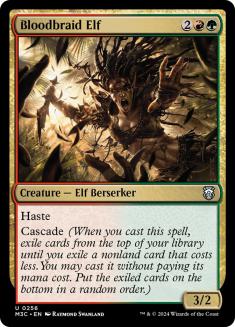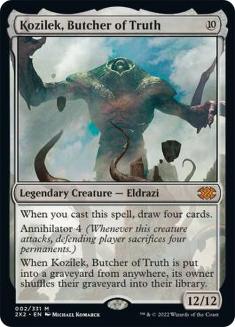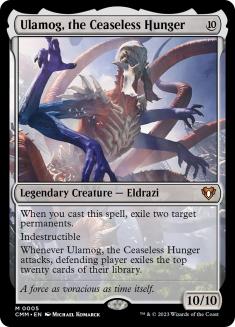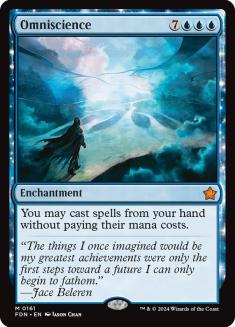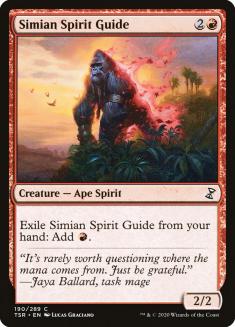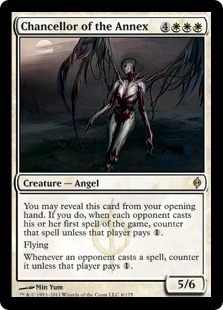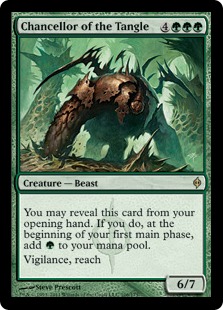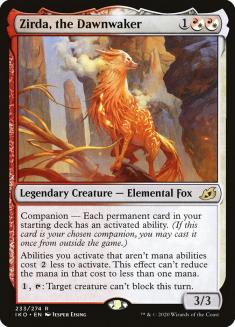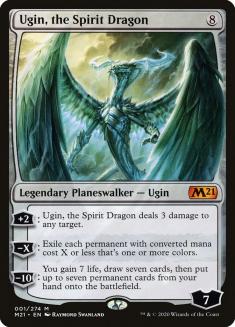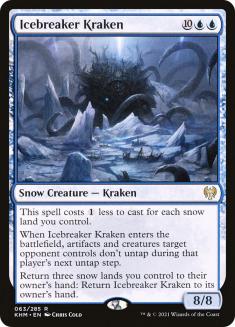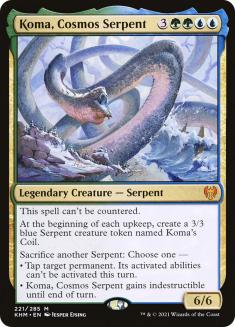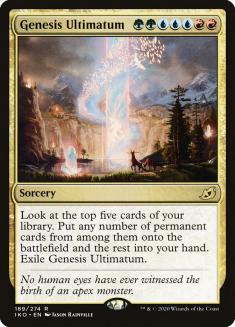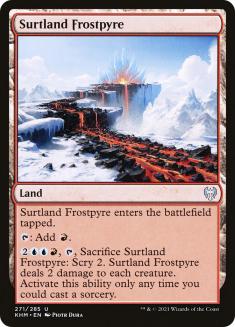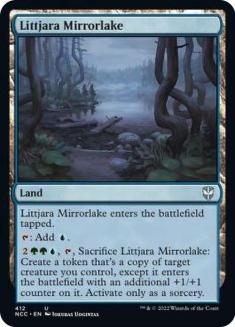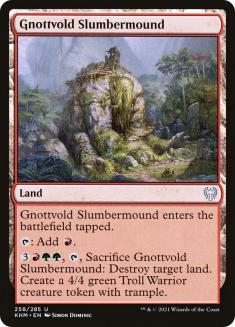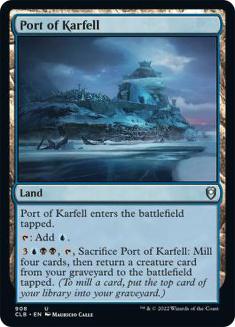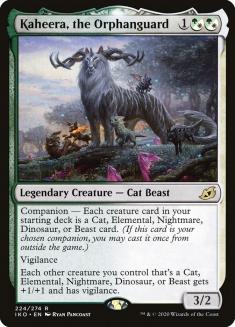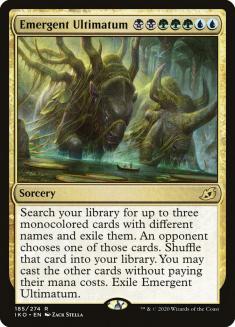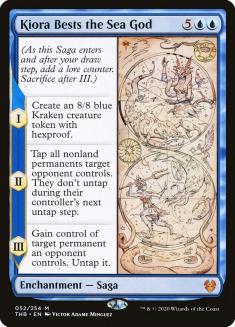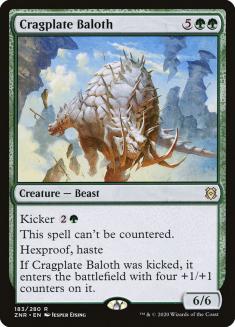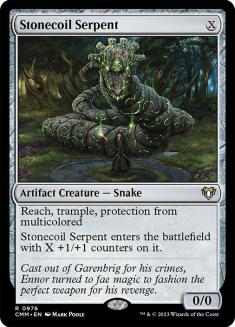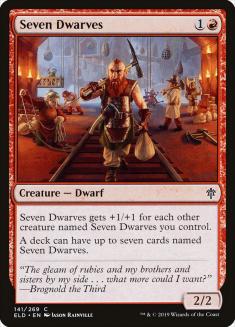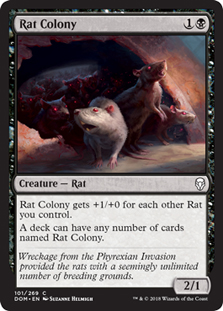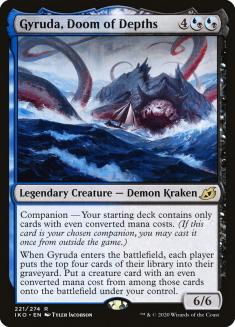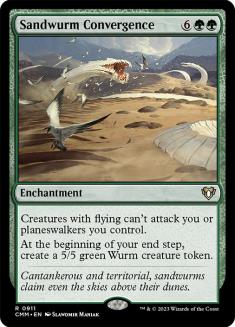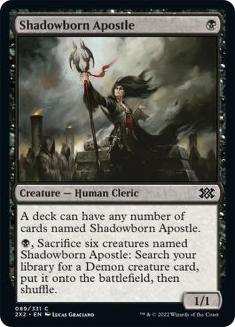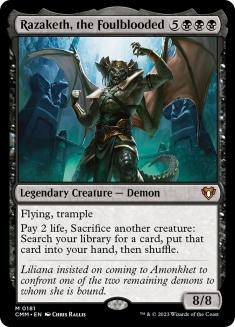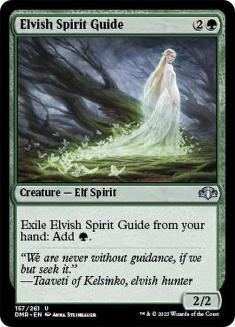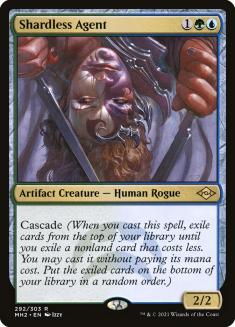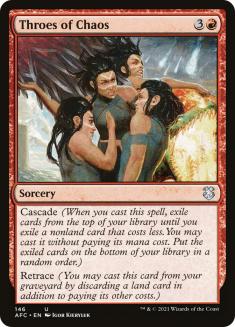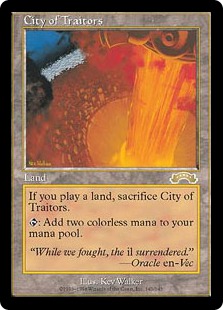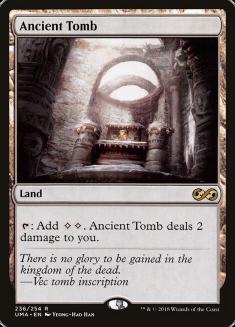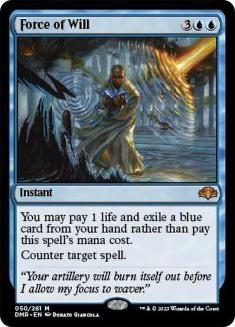Ahhh, yes, I always knew cascade might be broken someday…
One of the most dangerous cards in Kaldheim, Tibalt’s Trickery has a few different aspects to it.
On the surface, it’s a chaotic way to disrupt spells on the stack. If used against an opponent with a combo deck, it can be cast on a key card, leaving them with something random in its place, making the whole combo fall apart (maybe). Against permission, it can ensure your key spell resolves, or it can target your key spell and ensure something random resolves (and that the opponent gets nothing).
Of course, it can also be used as a form of selection. If you have a cheap spell that does little in this matchup, you can transform it into something random (which will hopefully be higher-impact).
This selection ability is the most abusable and, when taken to an extreme, can be used to create an extremely fast and warping combo strategy in Modern (with possible applications elsewhere).
To use Tibalt’s Trickery as a combo enabler, we need plans for what to counter and what to reveal.
One approach is to start with four copies of a single cascade card. Violent Outburst probably makes the most sense, since it shares a color with Tibalt’s Trickery, unlike Ardent Plea, and doesn’t require a target, unlike Demonic Dread.
If the only spell in your deck that costs less than three is Tibalt’s Trickery, you’ll always reveal it when you cascade (and with Violent Outburst still on the stack to target). If you play multiple Tibalt’s Trickeries, you risk one of them being the spell you Trickery into (and at that point, you won’t have a spell to target). However, if you play only a single copy, you obviously will never reveal one to itself.
Given that Trickery always changes the spell into something else, you don’t have to worry about any of the extra copies of Violent Outburst. This means if you only play with expensive cards beyond these five, you’ll always hit one. And if they’re all the same card, you’ll always hit it.
Emrakul, the Aeons Torn is the most powerful card you can cast in Modern, so playing some copies of it means you’ll be able to Violent Outburst into Tibalt’s Trickery into Emrakul on Turn 3 the overwhelming majority of the time. Immediately taking an extra turn and annihilating them is pretty close to unbeatable, making this a very, very reliable functional Turn 3 kill.
How reliable?
Magic: The Gathering Hall of Famer Frank Karsten’s analysis says the optimal configuration for maximizing Turn 3 goldfish kills comes from using three copies of Emrakul, giving us a 91.5% chance of casting Emrakul Turn 3 (at least not considering colors of mana or tapped lands in our manabase, but with room for 52 lands in the deck, we’ve got some bandwidth there).
Why three Emrakuls?
If you only play two or one, there’s a greater chance that you’ll draw or mill both (as one of the one, two, or three cards Trickery mills), making you whiff. If you play four, you risk getting Emrakul-flooded more often when you mulligan hard and then failing to go off Turn 3 on account of only having two land.
Remember, we’re all-in on mulliganing into Violent Outburst. Our algorithm for whether to mulligan is very straightforward. If the hand contains Violent Outburst and at least one land, but does not contain Tibalt’s Trickery, nor all three Emrakuls, it’s a keep. Otherwise, mulligan (yeah, yeah, once you get down to three cards in hand, you should keep the zero-lander, as long as it has Outburst and not Trickery, and depending on the matchup, you might do the same for four cards).
While this core eight-card package with no room for other spells might seem narrowing, there are lots of possible ways to build this 52-land manabase.
Creatures (3)
Lands (52)
- 4 Wooded Foothills
- 4 Karplusan Forest
- 1 Okina, Temple to the Grandfathers
- 1 Snow-Covered Mountain
- 1 Snow-Covered Forest
- 4 Stomping Ground
- 1 Ghost Quarter
- 4 Fungal Reaches
- 4 Gemstone Caverns
- 4 Grove of the Burnwillows
- 4 Misty Rainforest
- 4 Scalding Tarn
- 4 Eldrazi Temple
- 4 Copperline Gorge
- 4 Shrine of the Forsaken Gods
- 4 Cragcrown Pathway
Spells (5)
Sideboard

This version is mostly optimized for casting Violent Outburst on Turn 3 basically every time, avoiding any tapped lands.
Giving how hard we’re mulliganing, we’re going to be stuck keeping one-landers some of the time, assuming (reasonably so) that we’re drawing land each of the next two turns. If that final land is a tapped land, we’re missing a whole turn.
Of course, this isn’t an infinitely bad risk to take or anything. We do have 52 land, so it’s not like we’re gonna be jammed up that often if we have a good reason to play the tapped land. It’s just that scrying or cycling or activating a creature-land isn’t actually that impactful when we’re all-in on mulliganing to the combo anyway. If it does enough to justify the risk, it’s because of how much it helps us when we’re on “The Backup Plan.”
This is not to be confused with “Plan B,” mind you. Plan A is most certainly the aforementioned sequence. Plan B is when we accidentally draw Tibalt’s Trickery in one of our first two turns, at which point we now aim to cast Violent Outburst on Turn 5, and then Trickery it manually. That’s slower, to be sure, yet could easily still be good enough to win. Similarly, if we draw all three Emrakuls before the third turn, we need to chill a minute and wait until we can discard one to hand size; along those same lines, if we mulligan to one card and still don’t find Outburst, we just keep playing the game and hopefully we eventually draw one.
The real backup plan, however, is when our single copy of Tibalt’s Trickery is countered or our combo is otherwise locked out.
Teferi, Time Raveler makes casting cards from cascade illegal, since the cascade spell still being on the stack means sorceries aren’t legal. Lavinia, Azorius Renegade obviously thwarts mana cheats, this one included. Ethersworn Canonist or other cards that limit the number of spells people can cast per turn can easily lock out the combo for good, including even Deafening Silence, since technically, Emrakul would be the third spell for the turn.
Once we’re on the backup plan, hard-casting Emrakul is the most likely road to victory, so despite the risk of not drawing at least two colored mana sources by Turn 3, I’d like to try these lands that all stack to make a realistic possible road to fifteen.
Depending on how much we think we can get away with, it’s not like Fungal Reaches is the only storage land we can play.
Without all the Expedition Maps and Sylvan Scryings, we’re not actually as good at assembling the Urzatron as you might think.
The above manabase uses far too few Forests to make Castle Garenbrig appealing, but with a different manabase, it could be an option.
While there’s definitely some risk, both from extra colorless sources and from playing four copies of a legendary land, the value proposition of Gemstone Caverns speeding up your kill by a full turn is just too big to ignore.
I’m wary of using colorless land slots on “interaction,” but if we wanted to, Ghost Quarter is sort of a colored land source. After all, either we drew both of our basics or we didn’t.
The other part of the backup plan is just casting Jegantha, the Wellspring. Yeah, it’s not great, but it can potentially outmuscle hatebears like Lavinia or Canonist, and if our opponent has all disruption, at least we’ve got a big beater. Sadly, the mana can’t be used to cast Emrakul.
It’s corner-case in this deck, but if someone Thoughtseizes our Outburst and then we draw Trickery, we can actually Trickery our Jegantha on Turn 7 and still go off, or even sooner with a storage land or Temple of the False God.
Sideboarding presents some interesting challenges, since any spells we actually sideboard in kind of wreck our primary combo. Lands are, of course, okay, but as for spells, we need to think in terms of packages that are potentially worth giving up our combo for in the right spots.
The Madcap Experiment / Platinum Emperion combo is very compact and hits from a deceptively different angle. After all, regardless of Lavinia or Canonist, the combo is still dominant (though Teferi is still a beating). It’s especially well-suited to this strategy, though, since you can keep the combo in, and even if you hit a Madcap Experiment or Emperion, you’ve still got an unreal battlefield for Turn 3.
There’s no reason we need to be so slot-efficient, however. After all, if we give up our combo, we might as well get our money’s worth. We could potentially sideboard in fourteen to fifteen cards as part of a transformation if we wanted to.
Creatures (3)
Lands (52)
Spells (5)

This list goes heavy on green fetchlands in order to get extremely reliable access to Dryad Arbor as part of the transformational sideboard plan.
Having our lands find Dryad Arbor means Indomitable Creativity and Transmogrify are “one-card combos,” turning our Dryad Arbor into Emrakul 2/3rds of the time and/or Platinum Emperion.
The biggest problem with this deck’s approach is that it really undermines the Violent Outburst / Tibalt’s Trickery package. Maybe there’s a middle way, cutting Creativity (since X would be zero) but keeping Transmogrify. The problem there, however, is that it’s still fizzling when we reveal it to Trickery, since we don’t have a target most of the time on Turn 3.
If we did end up going the other way and actually more heavily invested in Indomitable Creativity, we might consider a single Gingerbread Cabin to find with all these green fetchlands, a Creativity target that doesn’t die to Fatal Push.
An alternative transformation/backup plan we might consider is building a Valakut, the Molten Pinnacle deck.
There’s room for a lot of Mountains when your deck has 52 lands in it!
Creatures (3)
Lands (53)
Spells (5)

Game 1, we’re still basically the same deck, albeit with Valakuts and tons of Mountains instead of all the two-mana lands.
Primeval Titan, Summoning Trap, and See the Unwritten all fit the bill as “one-card” combos we can play to potentially get a game-winning advantage, whether cast straight-up or Trickeried into on Turn 3.
Scapeshift could be an option, but it’s unfortunate how terrible of a hit it is on Turn 3.
It’s kind of funny, but we might also consider sideboarding a bunch of Bloodbraid Elves, the extra Emrakul, and one or two extra Trickeries (along with whatever Madcap and/or Titan plan). When it hits Outburst, we just end up with Trickery anyway, and even if we Trickery into another Bloodbraid or another Outburst (whichever we’re on), having an extra Trickery or two lets us keep going. Yeah, we’ll brick sometimes when we Trickery into Trickery, but once we sideboard in fourteen or fifteen cards, the odds aren’t so bad that we’ll fade the extra couple of Trickeries.
Once we’re okay with occasionally bricking, however, there are other options that open up to us.
If we load up on Grade A hits for our Trickery, we might be able to play more Trickeries and cascade cards without bricking too often. Our reliability of killing Turn 3 will drop, our mana will be worse, and our Trickeries will be worse on average; however, we will have more options for trying to combo off multiple times.
Maybe it’s too greedy, since Simian Spirit Guide is a horrendous reveal for Trickery; but the prospect of Turn 2 kills is very attractive. The following list has a 12.9% chance of Trickerying into a Simian Spirit Guide (along with a 9.7% chance of hitting another Trickery). Is it worth that kind of “failure” rate increase? After all, we do have another eleven cascade cards, so there’s not even the worst chance of comboing off again next turn (and when next turn is Turn 3, we’re not even behind in the game).
Creatures (16)
- 4 Simian Spirit Guide
- 4 Emrakul, the Aeons Torn
- 2 Kozilek, Butcher of Truth
- 4 Chancellor of the Annex
- 2 Ulamog, the Ceaseless Hunger
Lands (23)
Spells (21)

We could just play more Eldrazi for top-end, but I wanted to try cascade classic Chancellor of the Annex, giving us at least some kind of plausible interaction.
It’s not as strong as the Eldrazi on Turn 3, of course, but it’s still pretty good, and it can frequently be enough or buy us enough time to combo again. That it gives us such real opening-hand interaction is a huge boon for fighting Thoughtseize or permission decks.
Chancellor of the Tangle is another option people play in powered formats, but I think it’s a far, far worse hit to Outburst and the mana is wasted enough of the time in this deck, I’m not sure it’s worth it. That said, as a sideboard option, it could be a great way to try to give ourselves chances to duck under people, especially on the draw (thanks to Caverns), giving us more ways to Turn 1 kill.
Chancellor of the Annex, Omniscience, and Kozilek, Butcher of Truths do bring with them enough mana symbols that we have to give up Jegantha, but that’s not too big a deal. Jegantha is hardly the only companion with Tibalt’s Trickery applications, however.
With Zirda, the Dawnwaker in our sideboard, we can be assured of access to a spell to Trickery in lower-powered formats, giving us a consistency plan despite no access to cascade. While Standard doesn’t have that game-winning of threats to find, it is a low-powered-enough format that we might be able to plan to Trickery our Zirda on Turn 5 and not already be dead.
Creatures (8)
Planeswalkers (4)
Lands (40)

Big threats aren’t easy to come by now, but needing them to have activated abilities doesn’t make the hunt any easier. Sure, we get Ugin, the Spirit Dragon, but then we’ve got to work for the rest.
And it’s not like we can play just Ugins or anything. Once we’re playing four copies of Tibalt’s Trickery, that’d be basically a 42% failure rate.
Icebreaker Kraken is pretty sweet, having a big impact on the battlefield, protecting itself, and helping buy us time to just hard-cast more bombs. That it has the blink ability both protects our investment and makes the card Zirda-legal. Once we commit the majority of our manabase to snow lands, it actually makes a pretty great threat to just cast outright.
Definitely the third option, Koma isn’t nearly as effective at completely seizing control of the battlefield; however, it does have enough power to take over if left unchecked and an ability that can keep it somewhat protected if it gets any breathing room at all.
Finally, if we can count Genesis Ultimatum as a “hit” for Tibalt’s Trickery, it lowers our failure rate from 20% to 15.8%. What does it take for Genesis Ultimatum to be a hit? Well, if you reveal Ugin, Kraken, or Koma, you’re obviously way, way ahead, as you have one of the bombs plus four extra cards (to say nothing of the possibility of revealing two).
That’s already a nice 69%, but it’s not like we’ve necessarily lost if we reveal another Genesis Ultimatum. Assuming we aren’t just dead from the crack back, we’ll frequently be able to just cast the Ultimatum next turn (given that we already have five lands and presumably just put three or four more lands onto the battlefield). That brings us up to 78.3%, but there’s more.
If we draw two Tibalt’s Trickeries off our Ultimatum, we can try to set up a play where we Trickery an opponent’s spell and then Trickery that Trickery, “going off” again. This play raises a great point about our normal sequencing. While we’re planning to get our companion from our sideboard on Turn 3, Turn 4 can be an interesting one. If we have four mana open and our opponent cast something, they are risking us having two Trickeries and not only going off a turn early, but also guaranteed (since Trickery on Trickery means you can reveal Trickery, and companion-centric builds can have literally zero other misses).
Finally, there is the prospect of revealing lands that actually give us a bit of business.
Surtland Frostpyre is a little expensive to use, but it can help buy us time and find a way to go off again. It’s also a fine way to try to get more out of our Kraken or Koma, helping them actually control the battlefield.
Littjara Mirrorlake doesn’t work when you’ve got nothing else going on, of course, but it’s much higher-impact when you do. The Kraken and Koma aren’t necessarily enough to just win the way Emrakul and Ulamog are; however, a second copy goes a long way.
Gnottvold Slumbermound is also an option, but I’m not sure it gives us enough compared to all the other tapped-land options we could consider. We’re already playing many tapped lands between the snow lands and Evolving Wilds. We might not even want as many as we already have and the dimension this adds isn’t super-on-theme or anything.
While we don’t actually have black mana per se, if we could arrange that, Port of Karfell is actually quite a bit more exciting for our strategy. We’ve only got eight creatures, sure, but consider how the “Trickery for Genesis Ultimatum” sequence plays out. If we hit five lands, that gives us ten mana, meaning any Krakens or Komas in our hand are live. If we haven’t drawn any, that means our Port of Karfell is still almost 54% to reveal one if we use it blind, next turn. I’m not saying that’d be amazing or anything, but it’s not the worst option out of one of our lands. That said, balancing the black mana requirements with the Kraken’s appetite for snow is a whole thing, too.
Zirda isn’t the only companion we could plan to Trickery on Turn 5. Kaheera, the Orphanguard takes the Kraken and Koma out of the equation, but Ugin’s still fair game and we can set up a different Ultimatum pretty reasonably.
We can Emergent Ultimatum for Kiora Bests the Sea God, Cragplate Baloth, and another Tibalt’s Trickery.
If they give us Kiora Bests the Sea God and Cragplate Baloth, we get both and are dominating the battlefield.
If they give us Cragplate Baloth and Tibalt’s Trickery, we Trickery the Baloth (which can’t be countered). This leaves us with both a Baloth and another spin of the Trickery (this time with even better odds).
If they give us Kiora Bests the Sea God, we can either keep our big enchantment and let the Trickery get exiled, or we can Trickery it and reroll (again with better odds).
Creatures (3)
Planeswalkers (4)
Lands (41)
Spells (12)
Sideboard

This list has more high-impact Trickeries, though revealing the Baloth isn’t generally ideal. Having just one shot on Turn 5 might not be what we’d like, however, whether for speed or just having a single weak point.
While we could play Stonecoil Serpent and give ourselves chances of going on Turn 2, that does mean we need to naturally draw both Trickery and Stonecoil Serpent, and I’m not sure how we can reliably do that right now. The aggressive mulligan plan is extremely effective for finding a single key card, but it doesn’t assemble two-card combos nearly as reliably.
Seven Dwarves lets us play seven targets for our Trickery, while still letting us go off Turn 4. It also really gives us a lot more appreciation for any scrying and cycling we might do, since now we’re actually looking for something after our opening hand. We’re usually going to be content to just have a Trickery in our opening hand without a Dwarf, and then hoping to find one over the course of the next several turns.
Creatures (10)
Planeswalkers (4)
Lands (34)
Spells (12)

In Historic, there’s a more extreme version of Seven Dwarves available that operates on the same principle.
The right number of Rats to play is kind of going to depend on how reliable they actually are as a plan.
Creatures (27)
- 4 Craterhoof Behemoth
- 4 Ulamog, the Ceaseless Hunger
- 1 Razaketh, the Foulblooded
- 14 Rat Colony
- 4 End-Raze Forerunners
Lands (25)

It’s very possible that Gyruda gives us enough reason to prioritize creature hits instead of Omniscience, but it’s a pretty good hit.
If we moved away from Gyruda, another option to consider is Sandwurm Convergence, which can completely take over, albeit with one less hit in your deck for Gyruda.
Going up to Pioneer, we can do basically the same thing a turn faster thanks to Shadowborn Apostle.
Shadowborn Apostle also raises the interesting question of how much to actually “do it.”
Razaketh, the Foulblooded is a fine hit for Tibalt’s Trickery, anyway, and when there’s a good chance of us having an extra couple of 1/1s lying around, it becomes pretty decent. How realistic is it to get Razaketh from six Shadowborn Apostles?
Creatures (33)
- 23 Shadowborn Apostle
- 4 Ulamog, the Ceaseless Hunger
- 4 Kozilek, the Great Distortion
- 2 Razaketh, the Foulblooded
Lands (22)
Spells (5)

Sadly, even with 23 Apostles, I’m not sure the six-Apostle dream is realistic. Maybe we don’t need it to be that reliable, but that’s just 19% by Turn 5 (or 23% on the draw), and that’s to say nothing of an opponent having a single removal spell.
In Legacy, the bar is pretty high, since we already have access to Hypergenesis, Eureka, and other near-instant wins along these lines. We do have enough in common with Hypergenesis that it’s tempting to consider merging the two; however, that does kind of interfere with Elvish Spirit Guide and Simian Spirit Guide.
Still, whatever we considered, we do have access to a few extra strong cascade cards, Shardless Agent and Throes of Chaos.
While Shardless Agent is just really strong, Throes of Chaos is particularly interesting, since it can further reveal a Shardless Agent or Violent Outburst and keep going. It’s also naturally synergistic with City of Traitors and Ancient Tomb, while also being only a single color.
I’m not sure what to do with this, though. When I looked at possibly giving a transformational sideboard plan to a mono-red prison deck, it just seemed too unrealistic, since you can’t really play anywhere near enough land to be within fifteen.
You know who might actually be able to play enough lands, though…
Creatures (2)
Lands (45)
- 4 Wooded Foothills
- 4 Wasteland
- 4 Taiga
- 2 Savannah
- 1 The Tabernacle at Pendrell Vale
- 1 Karakas
- 2 Windswept Heath
- 2 Maze of Ith
- 1 Snow-Covered Forest
- 1 Glacial Chasm
- 1 Ghost Quarter
- 4 Dark Depths
- 1 Misty Rainforest
- 2 Verdant Catacombs
- 1 Bojuka Bog
- 2 Cavern of Souls
- 4 Thespian's Stage
- 1 Grasping Dunes
- 2 Blast Zone
- 1 Sunbaked Canyon
- 1 Hall of Heliod's Generosity
- 3 Field of the Dead
Spells (13)

Of course, is that even the right way to transform? Like, why not just start off as the Turn 3 kill deck and then transform into the resilient, inevitable lands deck?
Okay, I guess it depends on how many people we expect to be packing Force of Will Game 1, but still…
Creatures (3)
Lands (52)
- 4 Wooded Foothills
- 4 Wasteland
- 4 Taiga
- 2 Savannah
- 1 The Tabernacle at Pendrell Vale
- 2 Karakas
- 2 Windswept Heath
- 3 Maze of Ith
- 1 Snow-Covered Forest
- 1 Glacial Chasm
- 1 Stomping Ground
- 3 Ghost Quarter
- 4 Dark Depths
- 1 Misty Rainforest
- 2 Verdant Catacombs
- 2 Bojuka Bog
- 1 Eye of Ugin
- 2 Cavern of Souls
- 4 Thespian's Stage
- 1 Grasping Dunes
- 2 Blast Zone
- 1 Sunbaked Canyon
- 1 Hall of Heliod's Generosity
- 3 Field of the Dead
Spells (5)
Sideboard

Maybe it’s not just cascade…
Maybe it’s… dare I say it…
Is the mulligan rule the problem?

